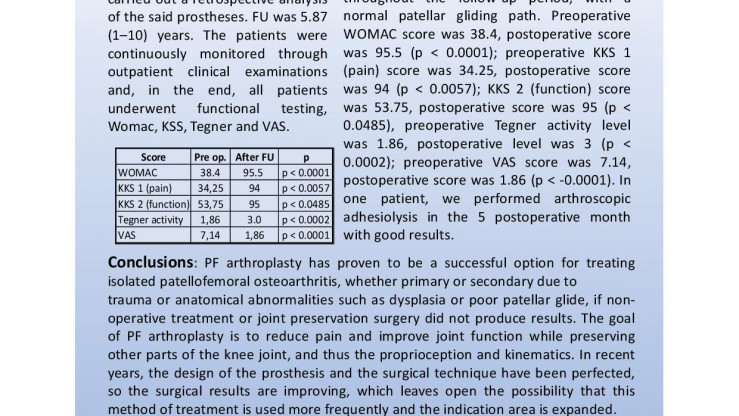Description
Objectives: The aim of this research is to present the initial results of patellofemoral (PF) knee joint prosthesis implantation, as well as a review of recent literature regarding indication for the said surgical procedure, the complications that can be expected and the surgical results.
Methods: In the ten-year time period from 2012 to 2021, we implanted 8 PF prostheses, which account for 0.7% of all implanted knee prostheses, 2 M and 6 F, age 55.3 (47–70), 4 L and 4 R. BMI 26.4 (22.9–31.9). The indication for surgery was secondary osteoarthritis following dysplasia or patellar instability in 5 patients, post-traumatic osteoarthritis in one patient, grade II chondromalacia with chronic anterior knee pain in one patient and patella baja following surgical treatment in one patient. We implanted 4 Sigma (DePuy Synthes, Warsaw, USA) and 4 Gender Solutions (Zimmer Biomet, Warsaw, USA) PF prostheses. We carried out a retrospective analysis of the said prostheses. FU was 5.87 (1–10) years. The patients were continuously monitored through outpatient clinical examinations and, in the end, all patients underwent functional testing, Womac, KSS, Tegner and VAS.
Results: We analyzed 7 patients, one of whom underwent conversion to TEP after 5.5 years. Range of motion is 0/128 (120–135) deg. Through clinical and radiological follow-ups, we found that the prostheses were stable throughout the follow-up period, with a normal patellar gliding path. Preoperative WOMAC
score was 38.4, postoperative score was 95.5 (p < 0.0001); preoperative KKS 1 (pain) score was 34.25, postoperative score was 94 (p < 0.0057); KKS 2 (function) score was 53.75, postoperative score was 95 (p < 0.0485), preoperative Tegner activity level was 1.86, postoperative level was 3 (p < 0.0002); preoperative VAS score was 7.14, postoperative score was 1.86 (p < -0.0001). In one patient, we performed arthroscopic adhesiolysis in the 5
postoperative month with good results.
Conclusions: PF arthroplasty has proven to be a successful option for treating isolated patellofemoral osteoarthritis, whether primary or secondary due to trauma or anatomical abnormalities such as dysplasia or poor patellar glide, if non-operative treatment or joint preservation surgery did not produce
results. The goal of PF arthroplasty is to reduce pain and improve joint function while preserving other parts of the knee joint, and thus the proprioception and kinematics. In recent years, the design of the prosthesis and the surgical technique have been perfected, so the surgical results are improving, which leaves open the possibility that this method of treatment is used more frequently and the indication area is expanded.




